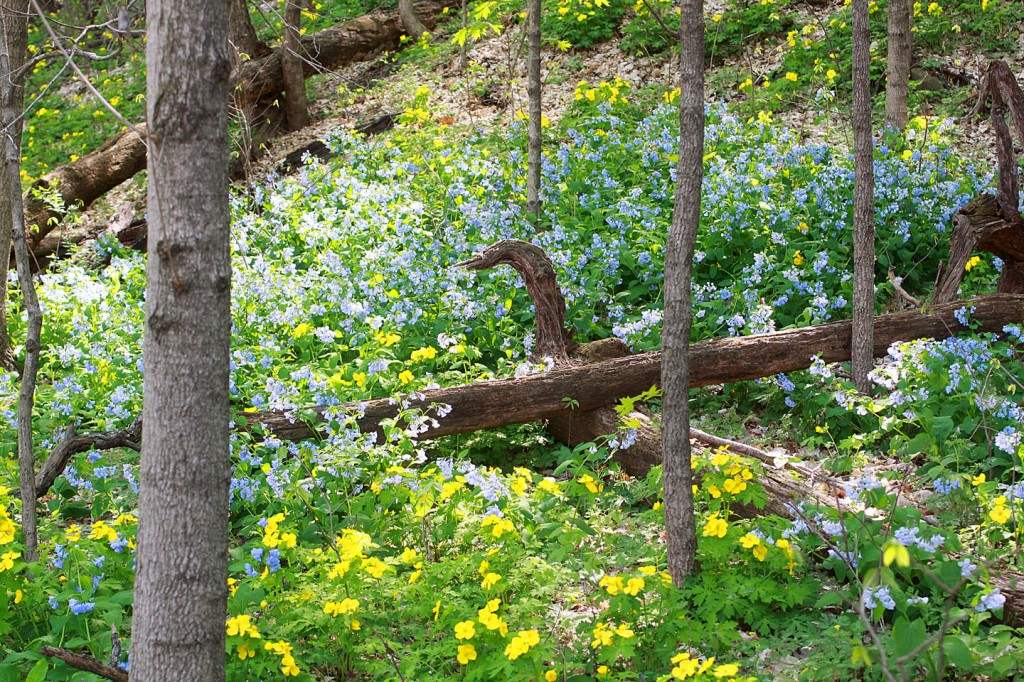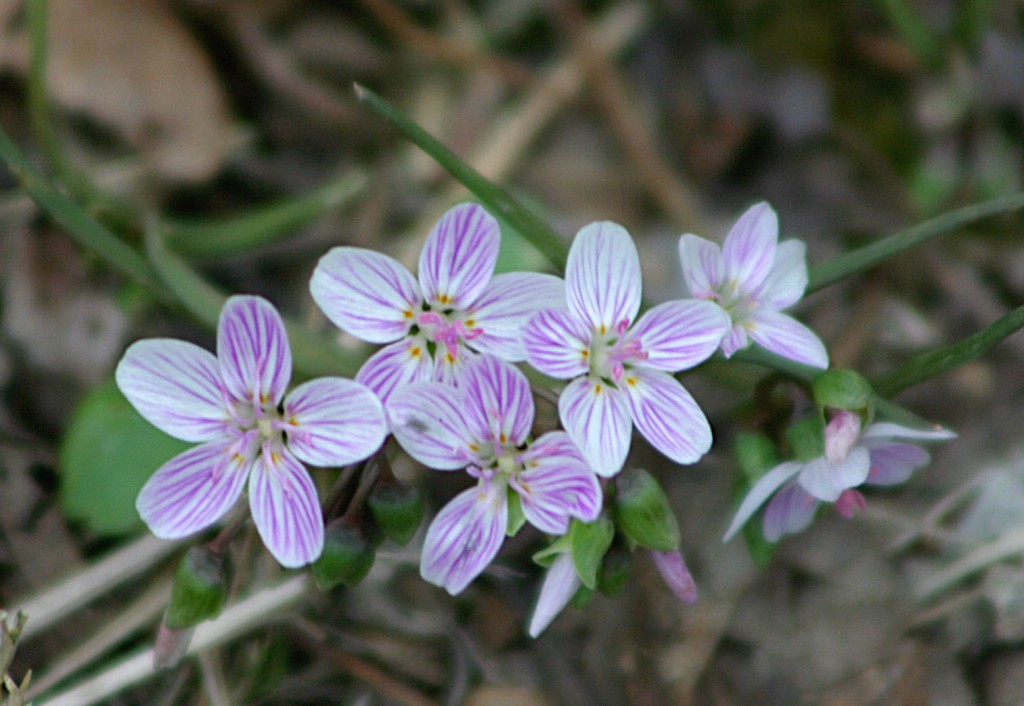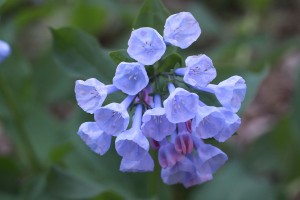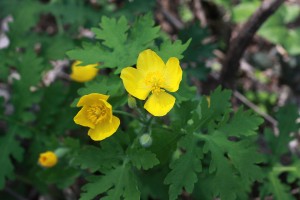Bluff lands Bloom with Vivid Floral Colors
By mid-March our blufflands will cast off the doldrums of winter drabness and begin to color its landscape with every imaginable shade, as wave after wave, from spring to first frost, of native wildflowers come into bloom.
The first flowers to blossom are called spring ephemerals, and their life strategy is a race against time. With the earliest spring woodland warm up, spring ephemerals will sprout, grow stems, produce flowers, and go to seed all before the forest trees leaf out and shade the forest floor. By June, the ephemerals will have died back to underground roots, leaving no trace that theirs was the earliest splash of colors to grace our woodlands.
Seven species of spring ephemeral wildflowers are very common in the bluffs and can be readily seen at Salt Lick Point Reserve, White Rock Nature Preserve, Stemler Woods Nature Preserve, and Fults Hill Prairie Nature Preserve, all open to public hiking.
Bloodroot (Sanquinaria canadensis) is a low-growing plant with eight-petaled, large, three-inch across, white flowers, with bright yellow stamens. The flowers only last one or two days. Bloodroot, which can be found along the moist creek hollows of the bluffs, was given its name for the red juice of its stems and roots. Native Americans used it for a fabric dye and paint, and taught this to the early French settlers who exported the roots back to France via the Mississippi. On the East Coast, Bloodroot is also known as “Indian Paint.” Early settlers also boiled the roots to make a cough medicine. Today, bloodroot is grown commercially for use as an anti-plaque additive in toothpaste and mouthwash.
Spring Beauties (Claytonia virginica) will begin to bloom on the moister north slopes and in the ravines of the bluff woods in March. The four to six inch plant, with two grass-like leaves, has beautiful five-petaled, one-half inch wide, pinkish-white flowers, with dark pink veins. Amerindians and our first European settlers ate the corms. These “fairy spuds” reportedly taste like radishes when eaten raw; if boiled, like chestnuts. In some parts of the country, Spring Beauties are called “Quaker Ladies.” Wild turkeys love them and will scratch the soil to dig up the treats.
Between Columbia and Valmeyer, swathes of Virginia Bluebells (Mertensia virginica) bloom along the talus slope at the foot of the bluff cliff face. During the 19th century, Virginia Bluebells were thought to cure respiratory ailments and were known as “Lungwort.” Pockets of dense, expansive colonies of the two-foot tall-stemmed plants also occur along streams and creeks and in low, shaded areas. The more westerly aspect of the bluff line in our area creates a less sun-filled, and so more moisture-retentive and slightly cooler, microclimate in which the bluebells flourish. The tubular-shaped intensely blue flowers age slowly into lavender-pink shades and are among the most dramatic blossoms in the springtime bluffs. Often likened to bits of sky fallen to earth, bluebells delight the eye with their early spring exuberance.
Dutchman’s Breeches (Dicentra cucullaria), also called “White Hearts” in the West, or “Soldiers’ Caps” in some parts of the East, carpet many areas of our bluffs.
The eight-inch perennial, with finely cut, gray-green, fern-like leaves sports beautiful white, yellow-tipped and double-spurred flowers that look like upside down leggings. All parts of the plant are toxic and can kill cattle and horses.
Celandine or Wood Poppies (Stylophorum diphyllum) are among the most beautiful spring ephemeral flowers in our blufflands. The foot tall plant has highly segmented and toothed leaves. The bright yellow flowers are two inches wide with four petals. Both native Americans and early settlers extracted a yellow die from the plant’s roots. The plant was widely believed to be a cure for liver problems and associated jaundice during the 1800s. Folklore has it that Celandine Poppy seeds were a common medicinal carried by physicians in early America. A Eurasian cousin to our Celandine Poppy is still used as a herbal remedy for liver trouble in Russia and East Asia. Celandine Poppies like wet feet and can be found in large colonies at the base of the bluffs or along creeks and deep ravines. They are often found growing and blooming with Virginia Bluebells, and, taken together, the brilliant yellows and heavenly blues is a wondrous sight to see.
Dwarf Larkspur (Delphinium tricorne) are scattered about throughout the bluffs.
The foot tall plant, with hand-shaped leaves, sports blue-to-violet loosely clustered flowers, with five showy sepals, four pointed upward and the fifth a downward spur.
Larkspur is extremely poisonous to cattle and horses, and in some parts of the country the plant is called stagger weed. Despite larkspur’s known toxicity, the plant was used during the Civil War to make a lotion to kill human parasites such as lice and mites.
Woodland or Blue Phlox (Phlox divaricata) is perhaps the most commonly seen early bloomer in our area, widely growing along rural wooded roadways in the county. The foot tall plant lofts clouds of sky-blue, five-lobed flower clusters. Pioneer medicine called for a tea of the plants leaves to help purify your blood. The plant is also known as Wild Sweet William, attributed to an 18th century ballad where Sweet William boards a ship and says goodbye to his beloved black-eyed Susan.
If you are interested in a guided tour to see these early spring flowers and learn more about wildlife in our bluffs, the Illinois Nature Preserves Commission, the Salt Lick Point Stewardship Committee, Kaskaskia Valley Audubon Society, HeartLands Conservancy, and Clifftop co-hosted an interpretive hike on Saturday, April 7th.
Clifftop, a local nonprofit organization, is focused on preserving and protecting area bluff lands.
A version of this article appeared in the March 16 2012 edition of the Monroe County Independent.
© 2011 all content rights reserved, Clifftop NFP.
Comments are currently closed.




